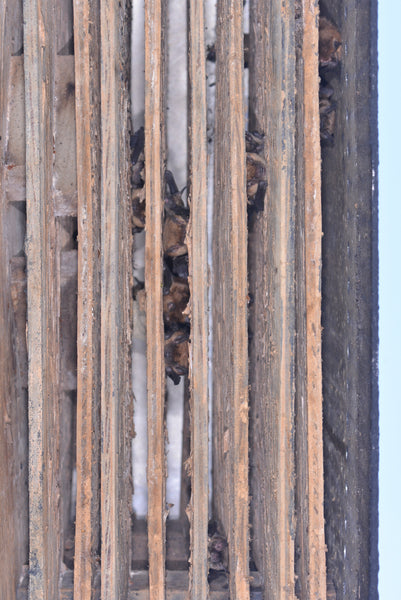
Watching the evening emergence also works well for finding bat entrances into a structure. Observers should be positioned at opposite corners of the structure so that an entire rectangular structure may be monitored by two people. By counting the exiting bats one evening during June-August, a low estimate of the colony can be obtained. This is important when determining the size and number of artificial roosts needed to manage a problematic colony. NEVER shine lights onto the structure during the emergence, as bats will refuse to exit. Finding these exits is also the first step in evicting bats from the structure.
How many bats are in my bat house?
Some mounting solutions prevent easy inspection of the box interior. Therefore, many folks find it just as fascinating to witness the nightly emergence. This event begins about fifteen minutes after your local sunset, and may last about thirty minutes. In Pennsylvania during July and August, bats will exit between 8:30 and 9:15 p.m. peaking between 8:45 and 9:00. By sitting on the ground so that the evening sky forms a relatively light, smooth backdrop behind your box. In this way you will see the bats emerging and they can easily be counted. Bats will not fly as often during high winds, heavy rain, or during a full moon, when they can be more visible to predators.
The Dawn Return
Fewer people have witnessed a morning swarm. Though much more impressive than the evening show, the dawn return requires the viewer to be watching about an hour before local sunrise. Once the box houses several dozen bats, it will be well worth the early rise to view the returning swarm. Instead of the animals quickly disappearing as with the evening show, at dawn bats exhibit a swarming behavior something like very busy bees in a beehive. They will return simultaneously and may swarm the roost for roughly thirty minutes before finally entering the bat house. Counting bats accurately during the dawn return is not possible since any count will likely be an exaggeration of how many animals are actually using the roost. On cool evenings the morning return may occur many hours before sunrise.
Won't they get in my hair?
Observing a good dawn return makes one really consider how sophisticated bats must be to stay afloat without colliding. When accounting for the incredible maneuverability, sensing ability, and intelligence in a small package, the common housebat to the animal world is more advanced than any military aircraft is to ours. One swarm in northeastern Pennsylvania contained an estimated thousands participants. A total of twenty man hours was spent working in the swarm, and in the end not one person was hit or was used as a landing pad. As an additional test of the animals, the four biologists were often working 100' inside a mine tunnel, a confined space!







